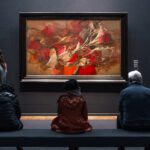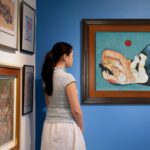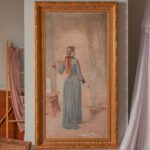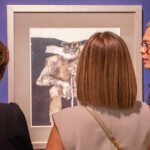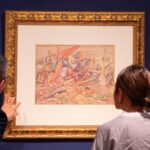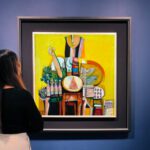There is a widely held belief that the friendship that exists between artists arises from a shared desire to create. But what is less known is that such relationships have had a profound effect not only on the history of art by influencing style and subject matter, but also in shaping a deeper understanding of these artists’ temperaments, motivations, and deeply held values. Here is one such Salcedo Story.
Victorio Edades’ life was one filled with love – whether it be for his family and friends, for his students, or for his art. Born to Hilario and Cecilia Edades in the barrio of Bolosan in Pangasinan, ‘Toriong’ (as he was affectionately called) was a greatly treasured blessing. Despite his family fleeing from conflict after Rizal’s execution, the young Edades had a carefree childhood spent flying kites in the hills of his idyllic hometown.
As a child, Toriong was greatly liked and evidently talented. His brother-in-law Gerardo Ayson was the first to acknowledge his ability in drawing. When he was able to attend public school, he would sometimes be assigned as an apprentice teacher in drawing and painting to his classmates. Thanks to this encouraging environment and upon the advice of their American principal, Edades and five other classmates applied to universities in the United States where they eventually settled, attending the University of Washington in Seattle.
The trip across the Pacific Ocean was arduous, but it was only the beginning of a lifelong journey. An old chest injury flaring up in the middle of his completing an architecture degree had a doctor insisting that he get adequate rest — after all, hunching over a drafting table was not at all appropriate for someone recuperating from an injury. And so he turned to painting.
After taking classes, Edades’ professors soon realized that there was little they could teach him for he had a seemingly natural talent in the understanding of art. He was later exposed to the works of modern artists when their works were exhibited in Seattle in 1923. While he admired the works of Cezanne, he still preferred to execute a realistic style that only used distortion to bring out notable details in the subject.
It wasn’t long before Edades met the American Jean Garrott, who came from an enlightened white family that did not adhere to the racism prevailing at the time and whom he eventually married. After their marriage, the couple moved to the Philippines.
On his return, Edades mounted a show at the Columbian Club on Taft Avenue with the help of Guillermo Tolentino. To his dismay, not a single sale was made and his works were badly reviewed in magazines. In a time when the academic style still reigned supreme worldwide, Edades’ skill had been doubted time and time again, going so far as having a student wonder openly if Edades had even studied anatomy while seeing him paint his landmark work The Builders, which now hangs in the Cultural Center of the Philippines.
Despite being previously advised not to pursue a teaching career, Edades would accept an offer to be the acting head of the newly-established Department of Architecture at the University of Santo Tomas’ College of Engineering. It was here that Edades’ love for his artistic practice and his devotion to his students would surface. Despite having only a handful of students, he spared no expense at ensuring their education. It was this passion and dedication to his students that allowed the university to grow into a prestigious institution for architecture, painting, and interior design, producing notable alumni.
Edades’ singular contribution to the definition and development of his country’s art, which brought him widespread recognition as the ‘Father of Modern Philippine Art’ would later gain him the Pro Patria medal during Rizal’s centennial celebration in 1961. This would be followed by an accolade during the Araw ng Maynila celebrations in 1964, and ultimately his promotion to National Artist for Painting in 1976. His works bridged post-impressionism with the inherent romanticism of Philippine folk life – genre subject matter being prevalent in the oeuvres of the academic realists of the 1920s.
Provenance
Two years after receiving the highest state honor, in 1978 Edades started reacquiring his paintings, seeing as he had not many left in his own collection. Edades found that his contemporary, Federico Aguilar Alcuaz owned his early work My Sweetheart, a portrait of his wife, Jean.
Belonging to the generation of artists that came after the Thirteen Moderns, Federico Aguilar Alcuaz greatly contributed to the definition and development of Philippine modernism, likewise receiving the dignity of National Artist. Both he and Edades were pioneers of Philippine modernism. Although they had very different artistic practices, they still found ways to interact and subsequently influence each other. While the public often has this romantic image of tortured artists working alone in their studios, the truth is, artists continually come together to collaborate, socialize, and learn from each other. Without this interaction, the waves of artistic movements and techniques that have been established over the centuries never would have come to pass.
In the book Edades: Kites and Visions by Lydia Rivera Ingle, Alcuaz was noted to have owned three Edades paintings: Portrait of Dr. Frederick Starr, My Favorite Corner, and My Sweetheart.
My Sweetheart was described by Ingle as “a beautiful portrait of Jean [Garrott] wearing her mother’s dark red winter coat … Here she sits in a lovely woman’s first bloom, a suggestion of a smile upon her full lips, a slender shoulder delightfully bare where the wrap has dipped. The light catches the delicate bone structure of neck, shoulder and dangling hand. This pose was painted by Edades more than once.”
In an email, Christian Aguilar, Alcuaz’s son, recounts how Edades sent a telegram and a letter to his father regarding the painting, asking for it back. The letter reads:
Regarding my telegram about the painting “My Sweetheart”… that particular painting is of tremendous sentimental value to us and we hope that we may get it back. I will gladly exchange another of my works for it, or paint your portrait or any other portrait you may wish.
With regards, sincerely,
Victorio C. Edades
Edades’ love for his wife was so great that he wanted My Sweetheart back and was willing to trade any of his other works for it. The circa 1930s oil on canvas painting of an unknown dark-haired beauty in the early post-impressionist style of the artist, which subtly brings to mind the polished Art Deco portraits of Tamara de Lempicka, is assumed to have been the painting for which My Sweetheart was exchanged by Alcuaz. Offered by the Aguilar family for the first time through Salcedo Auctions, there can be no doubt as to the superlative quality and sterling period of this untitled work, having been accepted by its original owner as a worthy replacement. This painting is both a lasting testament to Edades’ deep devotion to his wife, and to Alcuaz’s admirable empathy in agreeing to exchange her for another.
See the ravishing and art historically significant Edades painting ‘Untitled (The Muse)’ together with the over 240 lots on offer at the ‘Under The Tree: The Wish List’ auction, which takes place live and online on Saturday, 27 November 2021 at 2pm. Click here to view the catalogue, and to register to bid



